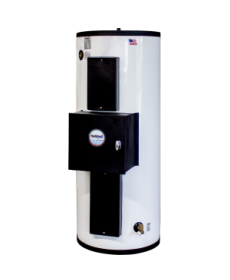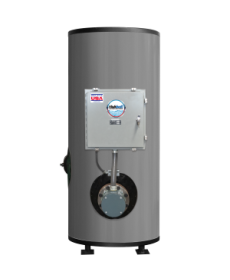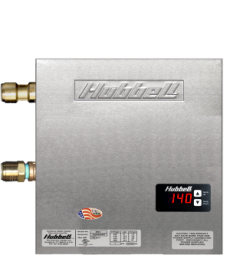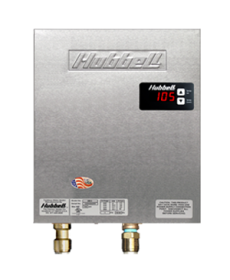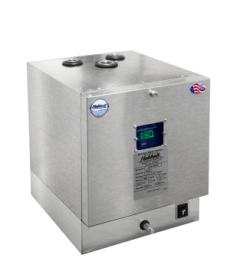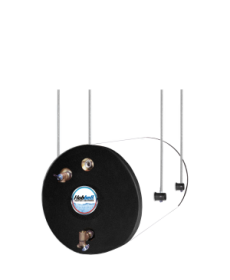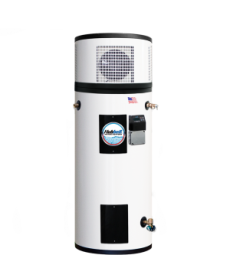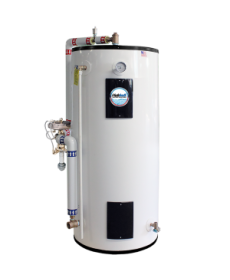
Tankless Electric Water Heater for Safety Applications
Hubbell Tankless ETX
Tankless Tepid Water
NEMA 4 Construction
Up to 162 KW - In All Three Phase Voltages

Description
The Hubbell model ETX Tankless electric water heater is a highly reliable and easily maintained heater designed for operation in a commercial or industrial application. The Hubbell ETX Tankless heater is compact, extremely efficient, takes up minimal space, and reduces operating costs. Hubbell's vast experience, meticulous engineering and advanced technology ensure that you can rely on the model ETX for your water heating needs in even the most demanding and critical applications. The Hubbell Tankless is the right choice for your tepid water requirements, as you will be providing your customer with a quality product that is long lasting, trouble-free and energy efficient.
Features
Heavy Duty Construction
- Constructed with high grade materials to ensure long operating life
- Simple to specify and easy to install and operate
- NEMA 4 Construction Standard
- Factory packaged heater provides trouble-free installation and operation
Reliability
- Engineered for your specific application to ensure reliable operation
- Wide selection of sizes to meet the needs of even the most demanding application
High Efficiency
- On demand heating eliminates costly and cumbersome storage tanks
- Instantaneous design reduces stand-by heat loss and significantly lowers operating costs compared to traditional storage systems
The Hubbell ETX Electric Tankless water heater provides high volume tepid water for safety drench systems with flow rates as high as 40 gpm. The heater contains high powered heating elements that heat water only when there is demand for tepid water. When tepid water is needed, a built in flow sensor measures the exact flow rate, and that data combined with temperature readings at the heater's inlet and outlet are processed by the electronic temperature controller. This data is continuously transmitted to the temperature controller, which constantly calculates the precise amount of power (kW) needed to achieve the desired temperature. A zero cross over firing signal is sent to the fast acting triacs in order to modulate the heating elements to the precise level needed to meet demand. The Hubbell ETX heater uses only as much power as is needed, while delivering accurate and consistent tepid water temperature.
Heater Overview

Dimensions



Note
Chart indicates twelve element (12) model types and eighteen (18) element model types
Model ETX Water Heater Specifications

General Specifications
Temperature Controller
A sophisticated electronic temperature controller with LED digital display provides the user interface. The temperature controller processes all flow and temperature data and calculates the precise amount of power needed to meet demand.

Full Heater Modulation
Each heating element is switched on/off using a fast acting solid state triac with zero cross over firing control. This switching schema provides full modulation of each heating element, ensuring that the precise amount of heat is added to meet demand. To improve operating efficiency and component longevity, each triac is mounted to a heat sink located on the incoming supply piping so that heat generated by the triac during the switching process is dissipated into the water.
Proper Power Integrity
All Hubbell tankless water heaters, including all 3 phase models, are engineered to operate as a balanced load and operate at 0.999 Power Factor. All Hubbell 3 phase models are designed for 3 wire (3 live, 1 ground) and 4 wire power systems and draw equal current across all conductors to maintain the power integrity of the users electrical system. Hubbell does not recommend the use of heaters that operate as an unbalanced load, as is common with staged heaters designed for star systems (3 live, 1 neutral, 1 ground) that require use of the neutral leg. All load switching in Hubbell tankless models is performed as zero cross over, eliminating phase angle firing interference and associated EMI issues.
Full Resource Staging
The Hubbell tankless control schema ensures that usage is equalized across all heating circuits. To achieve this, once the controller has calculated the precise amount of kW required, all circuits are energized in a staggered fashion such that each circuit is proportionally and independently energized and then time staggered between circuits. This Full Resource Staging Schema reduces EMI output, increases component longevity, and provides highly accurate and consistent hot water temperatures. For three phase models, all circuits are fully modulated and synchronized to operate as a balanced load.
Building Management Integration
Remote Control: Ability to remotely enable or inhibit the heating operation of the unit using one of the following two methods:
- Customer supplied 24VDC signal is user configured for either Inhibit Mode or Normal Operation Mode.
- Customer supplied volt free contact is user configured for either Inhibit Mode or Normal Operation Mode.
Priority Control: An integrated SPDT potential free dry contact (NO/NC 10A @ 240VAC) energizes when the unit is heating and de-energizes when not heating. This feature is useful when it is desirable to give the water heater priority over another electrical load to ensure that both are not operational at the same time.
Optional Equipment
- Type 316L stainless steel heating chamber for added corrosion resistance.
- Special construction features. Please consult factory.
- Inlet and Outlet Valve assembly simplifies installation and includes unions, shut offs, check valve, drain ports and pressure relief valve.
- Heating chamber built to ASME Section VIII and "UM" stamped.
- NEMA 1 enclosure for general purpose locations
- Remote Control Display allows the heater to be installed in a remote location. The 3" x 5" NEMA 4 display enclosure can be located up to 250' from the heater and gives the operator full remote control and monitoring capabilities.
- Explosion resistant construction for installation in a hazardous location. Standard is class 1, Division 2, Group B.
- If application requires other please specify Class, Division and Group rating required.
- NEMA 4X enclosure, available in aluminum or stainless steel.
- Floor Mount Enclosure Option.
- Emergency stop button, located on control panel door.
- UL Listed Package
- Outdoor weather package, for use in outdoor installations.
Please note: optional equipment may impact overall dimensions and weight. Please request submittal drawing from factory.
FAQs
Which is better for me, a tankless or storage type water heater?
It depends. A tankless water heater is sometimes referred to as a Point-of-Use (POU) or instantaneous water heater. Due to the relative small physical size of a tankless water heater compared to a storage tank water heater, a tankless option can be advantageous from a space saving perspective and can sometimes be installed closer to where you want hot water (hence the term POU). However, tankless heaters are not suited for many applications, so it is critical that before choosing to go tankless you have carefully considered all of the factors that sometimes make the tankless option more complicated and risky compared to a storage type water heater. In particular, you should understand the operational characteristics, maintenance requirements, reparability, and sometimes significant installation requirements of a tankless water heater before making a decision. Tankless units do not store heated water like a storage type water heater; they only heat water as there is demand and therefore must be sized to meet the maximum flow for the application. In some cases a tankless water heater may improve operating efficiency, but possibly at the expense of user comfort. Hubbell tankless water heaters are available inElectric Tankless or Gas Tankless.
How does my water heater ship?
All Hubbell storage type water heaters ship via common carrier and are classified by the Commodity Classification Standards Board under National Motor Freight Classification (NMFC) class 100. Each water heater is palletized and wood crated. All Hubbell tankless water heaters, when transported using common carrier, ship class 77.5. To provide the lowest transportation cost, in most cases the shipment is made on Hubbell’s account and the freight cost is added to the invoice, commonly referred to as “Pre pay and add”. For very large shipments, the most economical method (LTL or Dedicated Truck) for transporting the water heaters to the final destination will be analyzed by Hubbell's transportation department.
Does the Hubbell electric tankless water heater restrict water flow?
No. Hubbell electric tankless water heaters do not restrict water flow. Other brands may incorporate a flow restrictor device within their tankless heater or require a flow restricting device be installed in the plumbing or fixture itself as a method for controlling temperature. This is not the case for Hubbell electric tankless water heaters.
What is the difference between gas & electric tankless water heaters?
The most obvious difference between gas and electric tankless water heaters is the energy source that is used. Gas tankless heaters use either Natural Gas (NG) or Propane (LPG), but also use electricity (120v) to power an internal fan and other controls. Electric tankless heaters operate using only electricity. Electric tankless water heaters operate at higher energy efficiency, in the case of Hubbell the thermal efficiency is 98%+, compared to gas tankless which ranges from Energy Factor ratings of 0.82 to 0.96 depending upon model. Electric tankless is more efficient in large part because gas tankless models operate by burning gas, which is harder to control than electricity and is less efficient due to heat lost in the flue exhaust. Gas heaters require exhaust and/or fresh air intake venting, whereas electric heaters do not. Please note that efficiency and operating cost are two different things, to determine operating cost one must consider their cost of energy and usage in addition to the operating efficiency of the heater. Gas tankless water heaters cost more to purchase compared to electric tankless heaters. When replacing a storage tank type water heater with a tankless heater, it should be noted that both gas and electric tankless require changes to the existing plumbing and wiring of the tank they are replacing. When installing a new gas tankless heater, most installations will require a new/upgraded venting and gas line. When installing a new electric tankless heater, most installations will require upgraded wiring to the heater and replacement of the circuit breakers in the electrical panel. The largest available residential and light duty commercial gas tankless water heater is 199,000 BTU/Hr, but the most common size has an output of about 123,000 BTU/Hr. After factoring for energy efficiency, this is equivalent to roughly 36 kW. By contrast, the largest residential/light duty commercial electric tankless water heater is 27 kW, which has an effective output of 91,000 BTU/Hr. In terms of operation and maintenance, a gas tankless heater is considerably more complicated to maintain and service compared to electric tankless. In addition, an electric tankless heater will provide more accurate and consistent hot water temperature throughout a full range of flow rates compared to a gas tankless heater. However, gas tankless heaters because they are available in larger BTU sizes can provide a higher hot water flow rate/temperature rise for very large installations compared to a standard electric tankless heater.
What is the life expectancy of the Hubbell tankless water heater?
Depending on the type of installation, usage and water quality, the Hubbell electric tankless water heater can last from 15 to 25 years. In a typical application when properly maintained a Hubbell electric tankless water heater should have no problem lasting 25 years or more.
Is Tankless right for my application?
It depends. Due to the relative small physical size of a tankless water heater compared to a storage tank water heater, a tankless option can be advantageous from a space and weight saving perspective and can sometimes be installed closer to where you want hot water. Tankless water heaters do not store heated water like a storage type water heater; they only heat water as there is demand and therefore must be sized to meet the maximum flow and temperature rise for the application. Therefore, before proceeding with a tankless heater you must carefully understand your application and review your available power. Hubbell offers a wide range of electric tankless marine heaters go to Electric Tankless for details. It is critical that before choosing to go tankless you have carefully considered all of the factors that sometimes make the tankless option more complicated and risky compared to a storage type water heater.
Which NSF Standard is appropriate for this product?
The appropriate NSF Standard to use is NSF 5, titled “Water Heaters, Hot Water Supply Boilers, and Heat Recovery Equipment”. In the past the lead content requirement was only required in NSF 61 per Appendix G, but within the past few years changes have been made such that Appendix G has been removed and replaced by NSF 372, “Drinking Water System Components – Lead Content”. NSF 5 requires materials approved by NSF 51, “Food Equipment Materials” and the latest edition of NSF 51 requires that the materials comply with NSF 372. Therefore, NSF 5 now complies with the same low lead requirements as NSF 61.
Is this model approved by Massachusetts?
| MA Plumbing Approval Number | Hubbell Model | Expiration Date |
|---|---|---|
| P3-0914-61 | HD, J, V, PS, SLN, T | 9/3/2017 |
| P1-1114-201 | EMV, CR, R, JTX, ETX, TX | 11/5/2017 |
| P3-0813-66 | CE110, SE, E, HE, SH, H | 8/7/2016 |
| G1-0813-4 | GX, DGX, JBX, JGX, CX | 8/7/2016 |
What temperature is tepid water?
Hubbell has designed its safety shower water heater to provide as standard 85°F tepid water, although 75°F is available as an option. In the ANSI /ISEA Z358.1-2009 American National Standard for Emergency Eyewash and Shower Equipment standard, tepid water requirements are in the Definitions section and are clearly defined as water ranging between 60°-100°F. ANSI defines "tepid water" as "A flushing fluid temperature conducive to promoting a minimum 15 minute irrigation period. A suitable range is 16-38°C (60-100°F)". Medical professionals recommend that tepid flushing fluids be used to treat chemically injured eyes and body tissue. Temperatures that exceed 100°F can enhance chemical interaction with the eyes and skin. Conversely, water temperatures below 60°F can cause hypothermic shock. The ANSI Z358.1-2009 standard states that while cooler flushing fluids may provide immediate relief after chemical contact, “prolonged exposure to cold fluids affects the ability to maintain adequate body temperature and can result in the premature cessation of first aid treatment”.
Is 277 volt 3 phase voltage available for a water heater?
For all water heaters 277V is only an available option in 1PH, not 3PH. The 277V 1PH voltage is a derivation of your existing 480V 3Ph power. Where 480V is the line to line voltage on a 3 phase system and 277V is the voltage from any one of these lines to neutral, thus making the 277V power available in 1PH only.
Do Hubbell water heaters qualify as Low Lead?
Yes, all Hubbell water heater models qualify as meeting the low lead requirements of the “Reduction of Lead in Drinking Water Act” amendment to the “Safe Drinking Water Act” (SDWA) Section 1417(d) effective as of January 4, 2014. Hubbell certifies that its water heaters meet the following requirements of the SDWA and therefore are qualified and certified as Low Lead : (a)Hubbell water heater do not contain more than 0.2 percent lead with respect to solder and flux (b)Hubbell water heaters do not contain more than a weighted average of 0.25 percent lead with respect to all wetted surfaces of the water heater
What is the difference between solid-state and electromechanical relays?
Depending on the application, one switch may be more advantageous than the other. Please refer to this article to read more about the differences between solid-state and electromechanical relays.
Does my tankless water heater need a T&P relief valve?
Yes and no. NEC paragraph 422-27 requires all water heaters to be equipped with a temperature limiting device in addition to its control thermostat with the exception of instantaneous water heaters identified as being suitable for such use and with a capacity of 4L (1 gallon) or less. Hubbell tankless heaters are have a capacity of less than 1 gallon and are listed to UL Standard 499 which is recognized by NEC and thus meet the requirements of this exception. However individual state and/or local plumbing codes, such as Massachusetts and Kentucky, may require the installation of a temperature and pressure (T&P) relief valve. Therefore Hubbell recommends checking state and local plumbing codes for verification.
Warranty
Hubbell shall warranty all electrical components against defects in workmanship and material for a period of one (1) year from date of start-up, and the heating chamber for a full five (5) years from date of start-up, provided that the unit is started within three (3) months of date of shipment and installed and operated within the scope of the heater's design and operating capability. Labor is not covered under warranty. Each heater shall be shipped with a complete set of installation and operating instructions including spare parts list and approved drawings.
Technical Support
Our Technical Support Reps are ready to assist you. Please contact us today.


